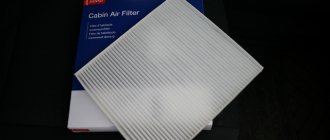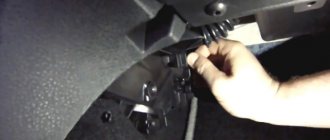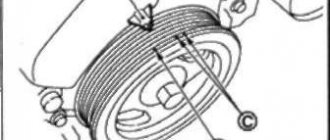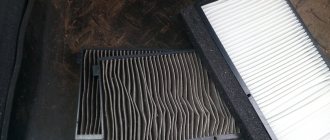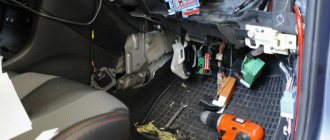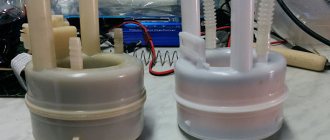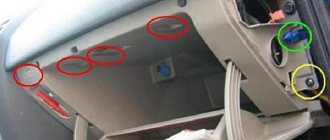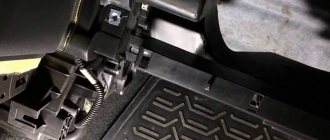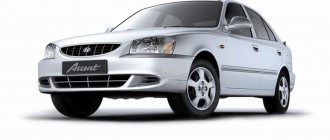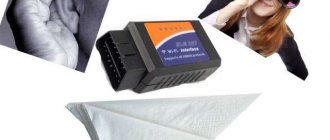A modern car is operated in a polluted environment, and soot, dust, and exhaust gases from the road penetrate into the interior of the car. To reduce harmful substances entering the interior of the car, a cabin filter is installed; it can also be called a stove or air conditioning filter. Replacing the Nissan Qashqai cabin filter must be carried out periodically, as on any other car; if the filter element is not changed on time, passengers will breathe dusty air, and the heater or air conditioner radiator will become clogged with dirt.
Replacing the cabin filter Nissan Qashqai (J10)
The compact crossover Nissan Qashqai has been produced since December 2006, presented in 2 generations:
- in the J10 body (2006-2013);
- in the J11 body (2014 - currently in production).
Nissan Qashqai cars in any configuration are equipped with air conditioning (climate control), so a cabin filter is extremely necessary here - the filter element protects the climate control system, preventing dusty air from entering the system.
According to the factory regulations, the air conditioner and heater filters should be replaced at every second maintenance, that is, approximately every 20-30 thousand kilometers. If you do not change the cabin filter (SF) in time, dusty air begins to penetrate into the cabin, and the radiator of the heating system and the air conditioner evaporator become dirty. As a result, the stove stops heating normally and the climate system does not work well. It should be noted that when operating a car in dusty conditions, the air conditioner (heater) filter is changed more often.
On the first generation Qashqai crossover, you can replace the cabin filter yourself; this work is not difficult to do, but it requires care and accuracy. We change the SF as follows:
- Move the driver's seat all the way back;
- to increase the space for removing the filter, you need to somehow fix the gas pedal in the lowered position;
- To the right of the driver below, remove the plastic casing; it is convenient to snap it off using a flat-head screwdriver. You should pull out the plastic protection carefully, trying not to break the latches. If the replacement is made during the cold season, it is necessary to warm up the car interior, in which case the plastic becomes more elastic;
- unscrew the mounts of the heater damper motor, move the assembly to the side so that it does not interfere with the removal of the filter element;
- We also dismantle the damper motor bracket itself, since it will also interfere with the removal and installation of the filter element;
- the filter itself is located to the right of the gas pedal, behind it there is a protective cover that must be removed. We pry off the cover with a screwdriver and remove it (it is held on by two latches);
- we get to the filter itself, pull it out;
- We install the new filter element in place; before installation, you can bend it slightly, but carefully - when the SF is in place, it will straighten. Please note that there is an arrow at the end of the filter element, so the filter must be installed correctly - according to the instructions, the arrow should be directed towards the floor
- after installing the filter element, you should make several hand presses on the end of the filter filter, this is done so that the filter is better straightened in its place;
- then we assemble it - put the damper motor and decorative cover in place.
That's it, replacing the Nissan Qashqai cabin filter is complete. Some Qashqai J10 car owners, when replacing the filter, recommend removing the pedal assembly so that the filter does not become wrinkled. This is not necessary - the original filter element is sufficiently flexible. Of course, a non-original SF may become wrinkled, but the installation of such parts should be avoided altogether; their quality is difficult to guarantee.
When to change, what interior to install
Replacing the cabin filter on the Qasqai J11 is provided for every 2nd scheduled maintenance, that is, after 30 thousand km. However, when used on Russian roads, within the period specified in the regulations, the cabin filter becomes quite clogged and ceases to perform its functions. Owners recommend replacing the cabin filter every 10-15 thousand kilometers.
The ideal option is to change the Nissan Qashqai cabin filter 2 times a year, once in the winter season, and once before the summer season. In the spring and summer, it is better to install coal, as it copes more effectively with various allergens and unpleasant odors. And in autumn and winter, the usual is enough.
Although the service book indicates specific terms for replacing the filter element, it is often recommended to carry out the replacement earlier, that is, not according to regulations, but as needed. The basis for replacement are signs of filter contamination:
- increase in air humidity in the cabin (fogging of windows);
- reduction of ventilation and heating system power;
- the appearance of unpleasant odors in the cabin (exhaust gases, smoke, fumes, etc.);
- noise appears when ventilation is turned on to maximum.
On the Nissan Qashqai J11, the cabin filter is usually installed as a carbon type. For its production, activated carbon is used (impermeable to carbon dioxide, dust, etc.) and synthetic material.
Tips for replacing the cabin filter element Qashqai j10
- Before removing the damper motor, you must make a mark and remember how this device was installed. If the slots are misaligned during installation, the stove will stop blowing hot air.
- It is recommended to move the stove damper to some extreme position, in which case during installation you will not have to look for the middle.
- In order not to interfere with the gas pedal when replacing the SF, you should disconnect the accelerator drive from the pedal itself and let it move down.
- If the car owner is not confident in his abilities, it is better to entrust the job of replacing the cabin filter to professionals.
- To make the new SF fit into place more easily, it should be slightly twisted along the axis.
Safety precautions during work
When repairing your car, pay attention to safety precautions. Considering that part of the work on changing the engine oil of a Nissan Qashqai engine can be carried out under the bottom of the car, and the ground clearance, depending on the vehicle configuration, is 185-200 mm, there is a possibility that you will be crushed by the car
Therefore, to prevent the machine from spontaneously rolling, be sure to install wheel chocks. If the car is raised with a jack, be sure to place stops under the car to prevent the car from falling.
Motor oil has a negative impact on the environment, so dispose of it and other repair waste in specially designated areas.
Source
Replacing the cabin filter Nissan Qashqai J11
On the new Nissan Qashqai models produced in 2014 and 2015, the SF is located in a different place - it is located in the passenger’s feet on the left side, below, next to the center console. Replacing the filter on a Qashqai J11 is even easier than on a Nissan J10, let's look at how this can be done.
We replace the cabin filter as follows:
- We enter the cabin from the front passenger side, move the seat all the way back;
- under the instrument panel (next to the center console on the left) we find a lever, in the picture below it is circled in a red square;
- press the lever and remove the plastic cover. The latch must be snapped off carefully; the plastic may break off;
- We remove the old filter, install a new one, and mount the plastic plug in place.
There are a minimum of replacement operations here, so almost any driver can do this work with his own hands. True, there are nuances in this matter - when removing the filter element, you don’t have to be afraid of crushing it, since it will no longer be useful, but installing the filter element is not always easy. The filter element fits tightly into its seat, usually it easily goes through two thirds, and then it has to be pushed in. Original filters are best placed in their place, but they are more expensive.
Increased product consumption
High oil consumption is a consumption that exceeds 0.5 liters per 1000 km. The engine consumes more lubricant due to increased engine speeds, so the tolerance of 3000 revolutions should not be exceeded so that Qashqai oil is not consumed more than normal. You should check the compression in the cylinders, the crankcase ventilation system, and possibly clean the valve. And then replace the oil seals and valve seats.
There are also cases when the lubricant is not consumed, but simply when replacing it could not be filled enough.
Experienced drivers often say: “I know why the engine constantly eats above normal.” They give examples of such situations on the forums and give advice:
- Seals that are leaking can eat oil on the Nissan Qashqai 2.0. This is very easy to check: oil leaks have appeared under the hood.
- Leakage through the gasket in the cylinder block occurs due to improper tightening of the power bolts or simply overheating of the engine.
- There is a gasket on the oil filter, it can leak. When replacing the filter, lubricate the sealing ring with lubricant and tighten the filter tightly.
- There are oil-deflecting valve caps that are installed in the engine. Leakage may occur through them.
- The oil scraper piston (control) rings have worn out, which eats up the lubricant.
- The problem is overheating of the piston rings, which can increase oil consumption.
- Increased oil burn appeared due to ring flutter. This happens due to a decrease in the elasticity of the compression rings.
- Coking of piston rings. Such rings cannot seal gases or lubricants. This is why the engine consumes more lubricant and compression decreases, but often only for one or two cylinders. Oil burns due to this problem can occur among drivers who use low-quality engine oil in Nissan Qashqai cars. That is, the product has very weak cleaning ability, or it has lost this ability due to long-term operation. Therefore, it should be recalled once again that the best solution is to use an original consumable that exactly fits all the requirements. This will help avoid such problems. Russian car dealers often use poor lubricants that do not meet the requirements.
- Destruction or breakage of the piston intervalve bridges. This may occur due to increased leakage of lubricant into the cylinders or deterioration of the combustion chamber seal. More liquid and boat gases flow through the ventilation system than necessary.
- The reason why cylinders consume oil lies in their wear. This is not difficult to detect. You should check them for scratches, burrs, chips; it is also possible to increase the diameter.
- Driving with increased lubricant viscosity.
- Delayed combustion in cylinders.
- Unfavorable modes of engine use affect oil consumption. A gasoline engine, which often runs at high speeds and loads, consumes significantly more consumables.
Choosing a cabin filter for Nissan Qashqai
For the Qashqai crossover, the industry produces original and non-original filters; car owners are offered products from different manufacturers:
- PKF "Nevsky Filter";
- Sat;
- BRONCO;
- JS Asakashi;
- Corteco;
- Concord;
- Mann;
- GodWill;
Depending on the manufacturer, materials may vary in price; the cost of parts ranges from 250 to 800 rubles. In addition to simple cabin filters, there are also carbon filters that filter the air more effectively, but they are more expensive. The advantage of coal SF is that it does not allow foreign odors coming from the road (street) to penetrate into the car interior. But this filter element also has a drawback - air does not pass through it well. GodWill and Corteco carbon filters are of fairly high quality and are a worthy replacement for the original.
On Nissan Qashqai J11 cars, SFs with a longitudinal “accordion” are installed without any problems; they easily fit into place and practically do not wrinkle during installation. For the Qashqai J11, there are non-original “consumables” that are almost twice as thick as the original, but it is unknown whether there will be normal air filtration with such elements.
Replacing the cabin filter Nissan Qashqai: video
Related articles:
- Causes and symptoms of malfunction of the VAZ-2110 lambda probe, replacing the oxygen sensor Exhaust systems with a catalyst began to be used on front-wheel drive cars of the VAZ family with the introduction of Euro-2 and Euro-3 environmental standards, an integral part of engines with […]
- Tiptronic: what is it and how does it work? Tiptronic is a type of automatic transmission installed on various technical equipment. This type of gearbox was first discussed at the end of 1990, when […]
- Technical characteristics of the Toyota Land Cruiser Prado, reviews from car owners The Toyota SUV Prado J150 was first shown at the Frankfurt Motor Show; the car went on sale on the European market in 2010. In North America, instead of Prado in […]

